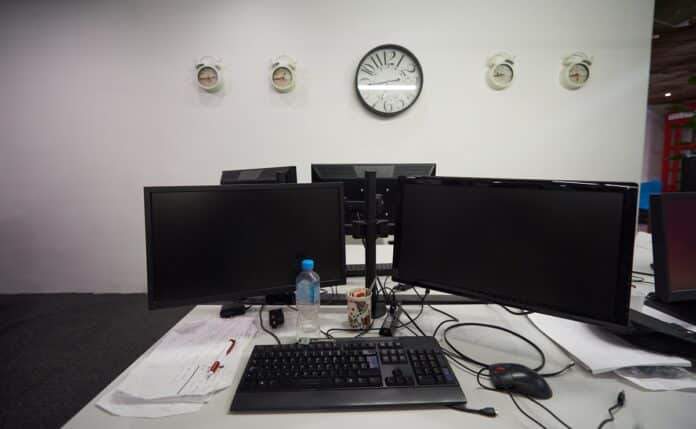
Disclaimer | This article may contain affiliate links, this means that at no cost to you, we may receive a small commission for qualifying purchases.
It isn’t easy to multitask at work and handle various projects simultaneously when you don’t have the best dual monitor stand.
Gone are the days when people only had one screen for all their tasks because now, even dual setups are being taken over by three monitor systems. But running all three screens in tandem isn’t as easy as it may seem, although it isn’t highly complicated either.
The most important thing is that the PC must support all the monitors without lagging, so you need to change the configurations or alter the settings. Today’s guide discusses all you must do to add a third monitor to a dual stand for your benefit.
How To Configure Multiple Monitors To Your Computer?

Since there are several details to keep in mind to configure multiple monitors, we have narrowed down the steps to help you.
1. Choose The Right Desk
Start by choosing the right desk before moving on to the other steps. To hold multiple monitors, ensure that the desk’s total weight capacity is greater than the combined weight of the monitors.
We are essentially looking at a vertical monitor setup or individual monitors held by a monitor arm. So, the desk needs to be sufficiently wide while satisfying your individual needs without compromising comfort.
It would be best to ask other people having a triple monitor setup about the preferred desk material, form factor, and other features.
2. Display Settings
If you have a slightly older computer, it might not support multiple displays. The only way to know is by looking at the video ports and determining whether they can run simultaneously. For three monitors, you will at least need three ports, so count the total number of ports and their types.
Most computers have –
- DVI
- VGA
- HDMI cable
- USB type-C
- Mini DisplayPort
- DisplayPort
We suggest you don’t use a graphics card or an integrated graphics card simultaneously to prevent the computer from lagging. Also, the graphics card model is crucial since not all graphics cards allow you to connect multiple ports.
3. Graphics Card And Extra Hardware
When you don’t have a discrete graphics card, the computer will have 2 ports, while motherboards with integrated graphics cards will support only two monitors. But a discrete graphics card will have ports for three screens, though it’s no guarantee you can use them simultaneously.
You can usually tell by Googling the name of the graphics card and the monitor setup. In case you don’t have a compatible graphics card or other hardware, the only option is to –
- Use a new graphics card
- Opt for a USB port to HDMI adapter
- Choose a suitable external multi-display adapter
- Have a docking station
We recommend choosing a graphics card like the RTX 3050 series or higher.
4. Integrated Cable Management
After ensuring the computer can support three monitors, it’s time to get the cables in order. If the unit already has a DisplayPort and 2 HDMI ports, you will need another DisplayPort and 2 additional HDMI cables to connect the extra monitors.
It’s also possible that the ports on the monitor don’t match those on the computer, for which the adapter will prove useful. Either opt for a DisplayPort-to-VGA adapter or cable adapter to connect the computer and the monitors.
Easy enough, right? The next step after configuring the display adapters is changing the display settings to run your high-end monitors.
5. Select Display Settings
Once you have upgraded the hardware and connected all the cables, you will have to configure the display settings. The process is slightly different depending on the Windows model, but we will discuss Windows 10 units.
If you right-click on the desktop, you will come across the “display settings” option, which was “screen resolution” in earlier Windows versions. Click display settings, and you should see the different monitors as 1, 2, and 3.
On the bottom, you will find the “identify” option to sync the displayed monitor with the corresponding monitor on the table. So, click identify and on 1 for the number 1 to show on one of the monitors. Do this for all the other monitors to make sure that the arrangement on the screen matches the actual arrangement.
If it doesn’t, use the mouse to drag and switch the order. But in some cases, one or more monitors might be missing, and you will have to use the detect option for proper configuration.
Before moving on to the final step, change the scale and layout for the apps, text, and other on-screen items, including orientation and resolution. Then from the drop-down menu, you will have to select the “extend these displays” option under the “multiple displays” tab.
This will allow you to extend the main display across all the screens.
6. Set up The PC
The last step involves arranging the monitors and sorting the desk to complete the setup. Use a 360-degree monitor arm to place the screens in the correct order and configure Windows to start using the PC.
How To Add A Third Monitor To A Dual Stand FAQs ?
Can you keep a dual monitor stand on a glass desk?
After reading our guide, you might wonder, can you mount a dual monitor stand on a glass desk? Yes, you can, but only if the glass surface can support the weight of the monitors. Before attaching the monitor arm to the glass, calculate the total weight of the monitors and the clamp mount to choose a glass surface with a higher weight capacity.
For added protection and to prevent the glass from shattering, some people add a wooden block between the C clamp and the monitor arm.
What are the advantages of a triple monitor setup?
Many people regard three screens as the perfect monitor setup because it increases efficiency as you can simultaneously run multiple applications without any hassle. This guarantees a smoother transition, while you can modify the screen settings of individual monitors for specific tasks.
You can have the high-resolution screen in the middle with secondary applications running on the other monitors. Best of all, people can multitask with three screens; for example, coders can operate the first or second monitor in portrait orientation with the others in landscape mode.
Are there any disadvantages of a three-screen setup?
While there are no downsides, you have to learn how to make adjustments, so learning how to adjust a dual monitor stand will come in handy. But one of the things people struggle with is making enough space on the corner desk or choosing a PC with enough ports. And if you’re a perfectionist, the gap between the screens and the varying orientations could be a little frustrating.

How To Add A Third Monitor To A Dual Stand Conclusion
Having more than one screen will be suitable for gamers, designers, architects, etc., to take their work experience to the next level. But it’s important to plan and ensure you have extra space to accommodate multiple screens, a stable power supply unit, and the necessary input ports.
And don’t expect easy installation because it will take a bit of time to configure the monitors. Thankfully, with our guide, you won’t go wrong and can enjoy a supreme three-screen PC setup for work or entertainment.

